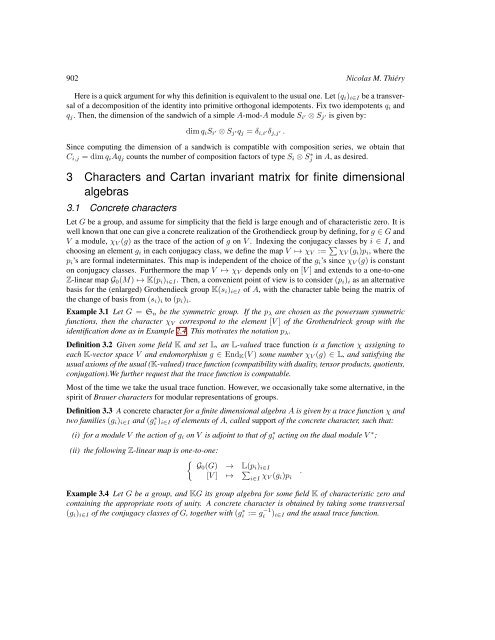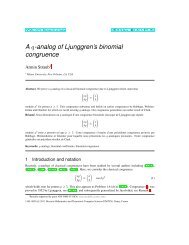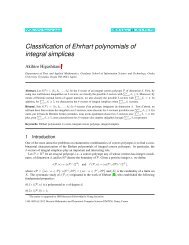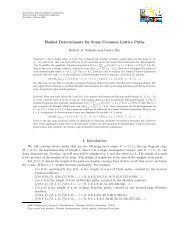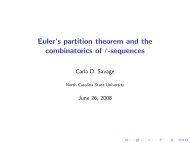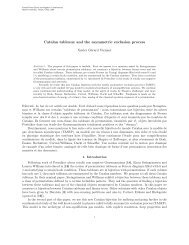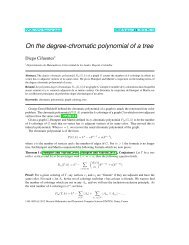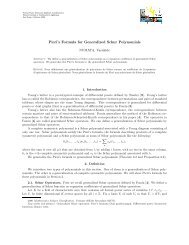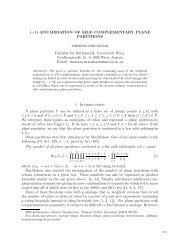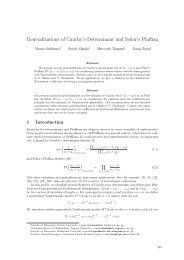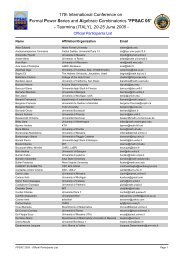Cartan invariant matrices for finite monoids - Nagoya University
Cartan invariant matrices for finite monoids - Nagoya University
Cartan invariant matrices for finite monoids - Nagoya University
Create successful ePaper yourself
Turn your PDF publications into a flip-book with our unique Google optimized e-Paper software.
902 Nicolas M. Thiéry<br />
Here is a quick argument <strong>for</strong> why this definition is equivalent to the usual one. Let (q i ) i∈I be a transversal<br />
of a decomposition of the identity into primitive orthogonal idempotents. Fix two idempotents q i and<br />
q j . Then, the dimension of the sandwich of a simple A-mod-A module S i ′ ⊗ S j ′ is given by:<br />
dim q i S i ′ ⊗ S j ′q j = δ i,i ′δ j,j ′ .<br />
Since computing the dimension of a sandwich is compatible with composition series, we obtain that<br />
C i,j = dim q i Aq j counts the number of composition factors of type S i ⊗ Sj ∗ in A, as desired.<br />
3 Characters and <strong>Cartan</strong> <strong>invariant</strong> matrix <strong>for</strong> <strong>finite</strong> dimensional<br />
algebras<br />
3.1 Concrete characters<br />
Let G be a group, and assume <strong>for</strong> simplicity that the field is large enough and of characteristic zero. It is<br />
well known that one can give a concrete realization of the Grothendieck group by defining, <strong>for</strong> g ∈ G and<br />
V a module, χ V (g) as the trace of the action of g on V . Indexing the conjugacy classes by i ∈ I, and<br />
choosing an element g i in each conjugacy class, we define the map V ↦→ χ V := ∑ χ V (g i )p i , where the<br />
p i ’s are <strong>for</strong>mal indeterminates. This map is independent of the choice of the g i ’s since χ V (g) is constant<br />
on conjugacy classes. Furthermore the map V ↦→ χ V depends only on [V ] and extends to a one-to-one<br />
Z-linear map G 0 (M) ↦→ K(p i ) i∈I . Then, a convenient point of view is to consider (p i ) i as an alternative<br />
basis <strong>for</strong> the (enlarged) Grothendieck group K(s i ) i∈I of A, with the character table being the matrix of<br />
the change of basis from (s i ) i to (p i ) i .<br />
Example 3.1 Let G = S n be the symmetric group. If the p λ are chosen as the powersum symmetric<br />
functions, then the character χ V correspond to the element [V ] of the Grothendrieck group with the<br />
identification done as in Example 2.4. This motivates the notation p λ .<br />
Definition 3.2 Given some field K and set L, an L-valued trace function is a function χ assigning to<br />
each K-vector space V and endomorphism g ∈ End K (V ) some number χ V (g) ∈ L, and satisfying the<br />
usual axioms of the usual (K-valued) trace function (compatibility with duality, tensor products, quotients,<br />
conjugation).We further request that the trace function is computable.<br />
Most of the time we take the usual trace function. However, we occasionally take some alternative, in the<br />
spirit of Brauer characters <strong>for</strong> modular representations of groups.<br />
Definition 3.3 A concrete character <strong>for</strong> a <strong>finite</strong> dimensional algebra A is given by a trace function χ and<br />
two families (g i ) i∈I and (g ∗ i ) i∈I of elements of A, called support of the concrete character, such that:<br />
(i) <strong>for</strong> a module V the action of g i on V is adjoint to that of g ∗ i acting on the dual module V ∗ ;<br />
(ii) the following Z-linear map is one-to-one:<br />
{<br />
G0 (G) →<br />
[V ] ↦→<br />
L(p i ) i∈I<br />
i∈I χ V (g i )p i<br />
.<br />
Example 3.4 Let G be a group, and KG its group algebra <strong>for</strong> some field K of characteristic zero and<br />
containing the appropriate roots of unity. A concrete character is obtained by taking some transversal<br />
(g i ) i∈I of the conjugacy classes of G, together with (gi ∗ ) i∈I and the usual trace function.<br />
:= g−1 i


